Preserved Lemons
This post may contain affiliate links. See my disclosure policy.
Get ready to unlock one of the grand secrets of Moroccan and Middle Eastern cuisine by learning how to make preserved lemons in this step-by-step tutorial. These homemade preserved lemons are a powerhouse ingredient that will infuse your dishes with such an incredible flavor and absolutely transform any dish you add them to, whether savory or sweet. Just a few minutes of your time will give you this magical ingredient that keeps for months and you can enjoy all the year through!
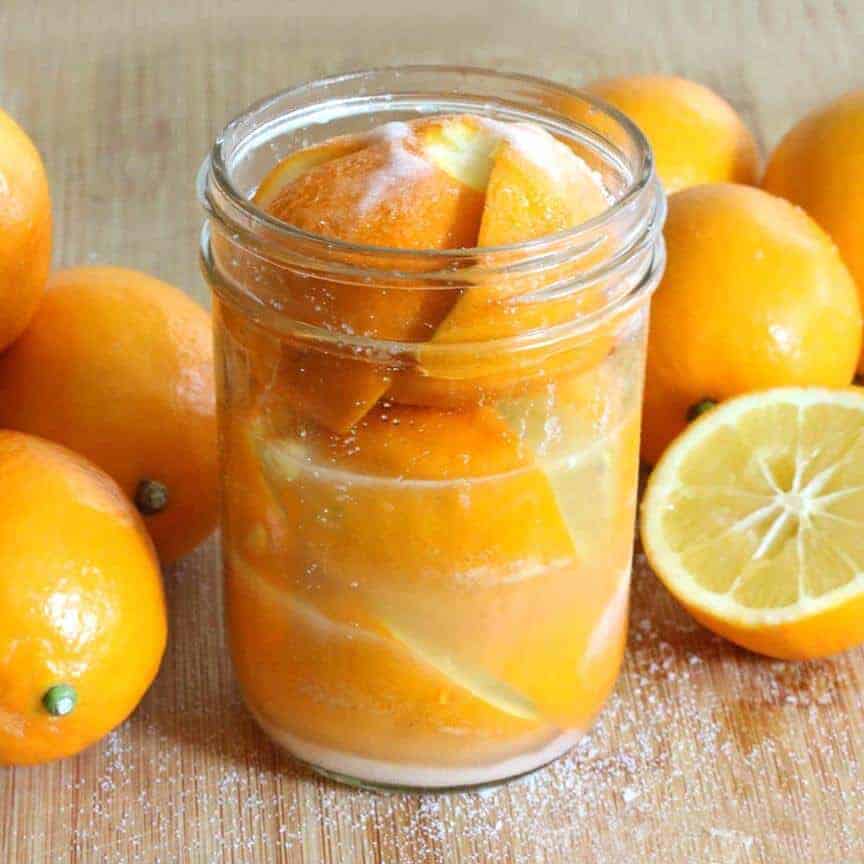
If you’re a fan of Moroccan and Middle Eastern cooking you’ve probably had the experience of thumbing through recipes, drooling all the while, earmarking the ones you particularly like, only to then scan through the ingredients and see the words: “Preserved Lemons”. Your heart sinks for a moment as you realize you are sorely lacking this crucial ingredient. And so with disappointment you un-earmark that page and move on to the next recipe. DON’T let that scenario stop you again. Because nothing could be easier than making your own DIY preserved lemons! These are one of my most favorite “secret” ingredients and I’m going to show you exactly how to make them and how to use them in lots of delicious ways!
What Are Preserved Lemons?
Preserved lemons are lemons that have been packed in salt and their own juices and are left to cure for about a month. During that time the flavors transform in which the acidic tartness disappears and you’re left with a very amplified and complex lemon flavor. Think of preserved lemons as lemons on steroids. They add an intense, concentrated lemon flavor to the dish without all the sour tartness. The preserving process tempers the tartness while accentuating the lemon flavor. In other words, mildly tart but intensely lemony. And if you’re a lover of all things lemon, preserved lemons need a permanent place in your pantry. I can assure you, there is virtually always a jar of these in my fridge!
This preservation process also extends the shelf life of the lemons and they’ll keep for around 6 months in your fridge and even longer if you can them. Over time the lemons become soft and to use them you simply remove however much you need, scrape off the fleshy interior, rinse off the peel, dice it up, and add it to your dishes. Preserved lemons have been around for centuries and are used extensively in Middle Eastern and North African cuisines, most famously Moroccan food. Their unique flavor adds an incredible amount of flavor to a wide variety of savory dishes and desserts.
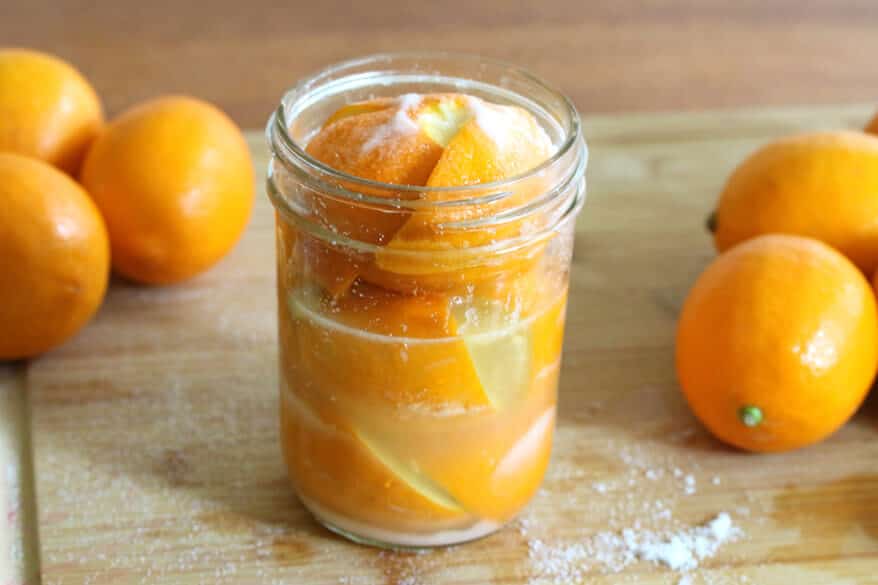
How to Use Preserved Lemons
You’ll find preserved lemons called for in a lot of Middle Eastern and Moroccan recipes, everything from tagines to stews and salads and add a uniquely tangy, salty, and mildly sweet flavor. They can be added to any dish that calls for or can benefit from a touch of lemon flavor. And that includes desserts. Here are just a few ways to use preserved lemons:
- Tagines and stews: a little goes a long way to adding life and flavor. Try them in my Moroccan Harira and Moroccan Chicken Tagine. They’re also great in a variety of bean stews and lentil soups.
- Chicken, duck, beef, lamb, pork, and fish: preserved lemons pair beautifully with any protein. Try them in my Moroccan Chicken (Djej Makalli). And of course lemon and seafood are soulmates. Now just wait until you’ve paired it with preserved lemons and your life is forever changed.
- Salads: Finely mince and toss them into your salads, including pasta salads. They also pair beautifully with grain salads and grain bowls. Try them in two of my personal favorites, this Moroccan Chicken Salad and Curried Couscous Salad.
- Rice, grain, and pasta dishes: try them in my Salmon Risotto – it’s a match made in heaven.
- Marinades: Incorporate them into marinades for chicken, lamb, pork and fish. They add just touch of acidity and a whole depth of flavor.
- Dressings, sauces and dips : Blend them into dressings, vinaigrettes and sauces for an exciting flavor punch. They also work really well in creamy sauces. Add some to your Hummus or Baba Ganoush or to some Greek yogurt along with fresh dill for a refreshing dip.
- Sandwiches and Wraps: you can even add them to your burgers for a fun flavor boost. Oh, and add them to Falafel!
- Salsas and Relishes: chop some up and it to your salsas and relishes for a unique lemony twist like my Mango Salsa and Pineapple Salsa.
- Roasted Vegetables: Toss your roasted veggies with some butter and finely minced preserved lemons for a fabulous flavor. They pair particularly well with root vegetables and cauliflower.
- Cakes, Cupcakes, Muffins, etc: Anything that you would add lemon zest to, try adding some finely minced preserved lemon. Try it in our Preserved Lemon and Ginger Pound Cake.
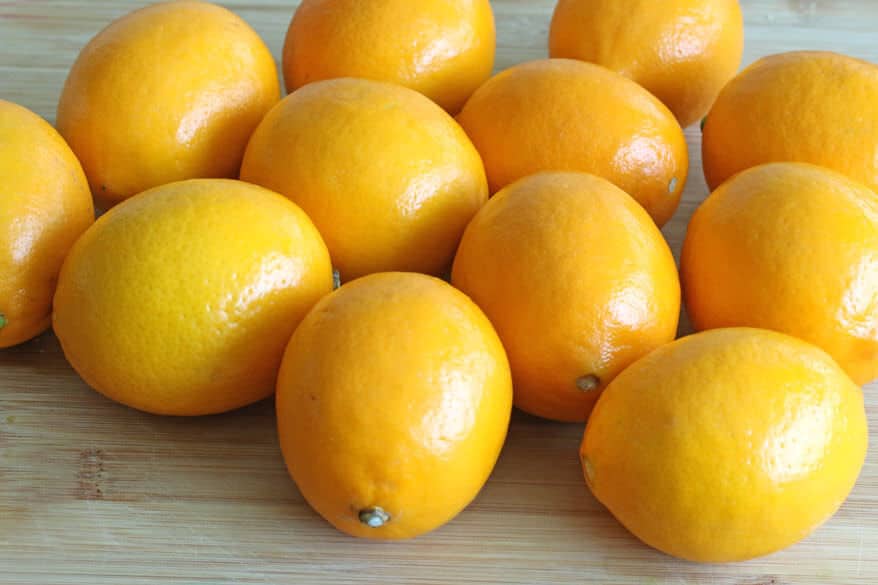
What Kind of Lemons Are Best?
Doqq and boussera lemons are commonly used in Morocco. They have thinner skins and are sweeter than regular lemons. A great substitute is Meyer lemons. If you can’t find Meyer lemons you can use regular lemons such as Eureka or Lisbon. Organic is ideal since it’s the lemon rinds that are eaten.
Variations
Did you know, you can also make preserved limes, oranges, grapefruit and kumquats! The process is identical but because high acidity is required for proper preservation and other citrus varieties have a lower acid content, you will still need to top off the jars with lemon juice. Experiment with these other citrus varieties for some fun flavor variations.
How Long Do Preserved Lemons Last?
Preserved lemons can be stored at room temperature but they’ll ferment very quickly that way and won’t keep as long. It’s recommended to store them in the fridge, in a glass jar with a lid, where they will keep for up to 6 months, and quite possibly longer. Just check periodically for any signs of mold or off colors and smells.
Preserved Lemons Recipe
Let’s get started!
Organic is ideal if you can find them since it’s the rinds that are eaten. If you can’t find organic, let the lemons soak in a vinegar-water solution for a few minutes to clean the outer peels, then rinse.
Trim the nubs off both ends of each lemon.
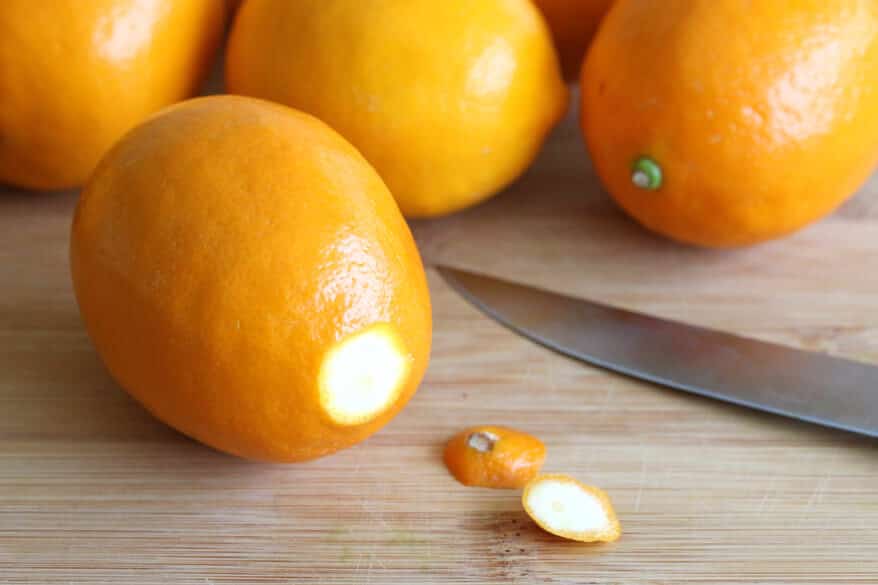
Slice the lemons into quarters, leaving the ends attached. So slice down just a little over 3/4 of the way.
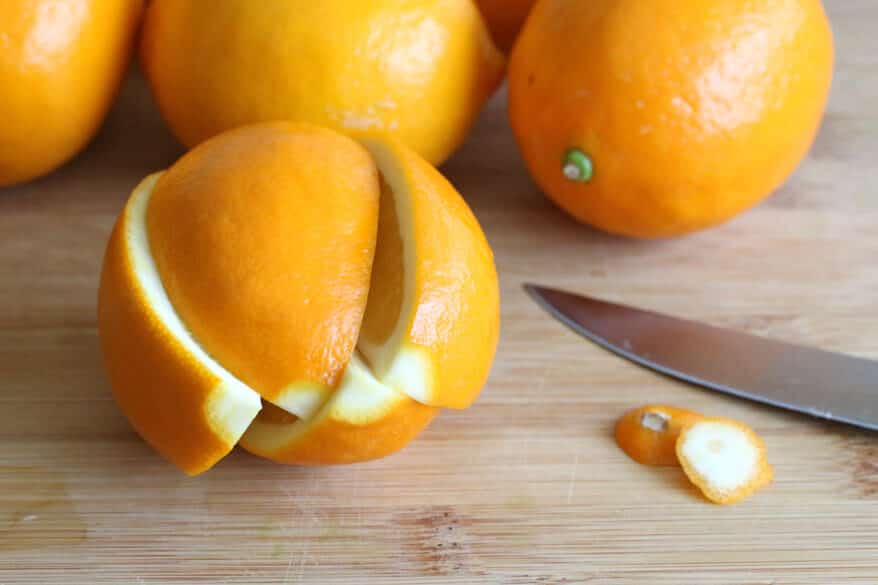
Put a teaspoon of salt in the bottom of a pint-sized jar. Put another teaspoon of salt into the quartered lemon.
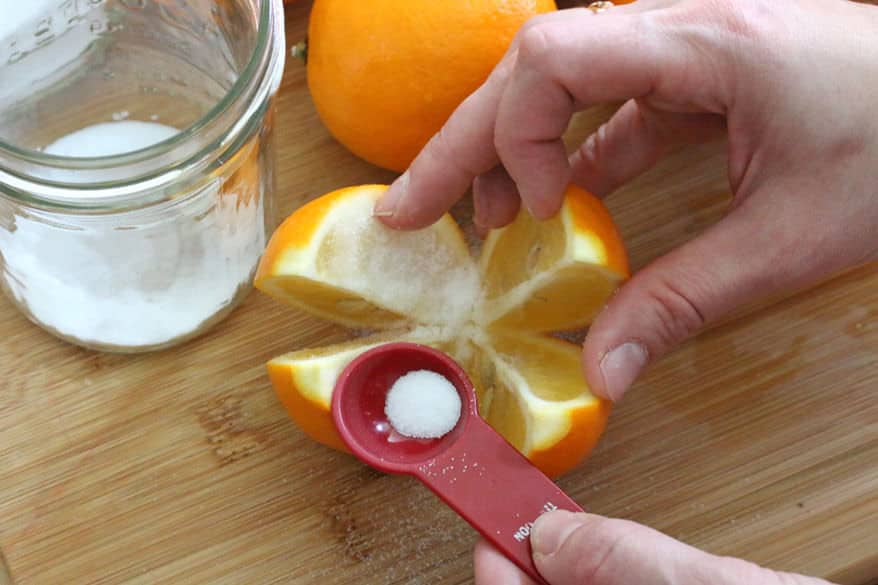
Stuff the lemon into the jar, open end down, and push hard to squish it and release its juices.
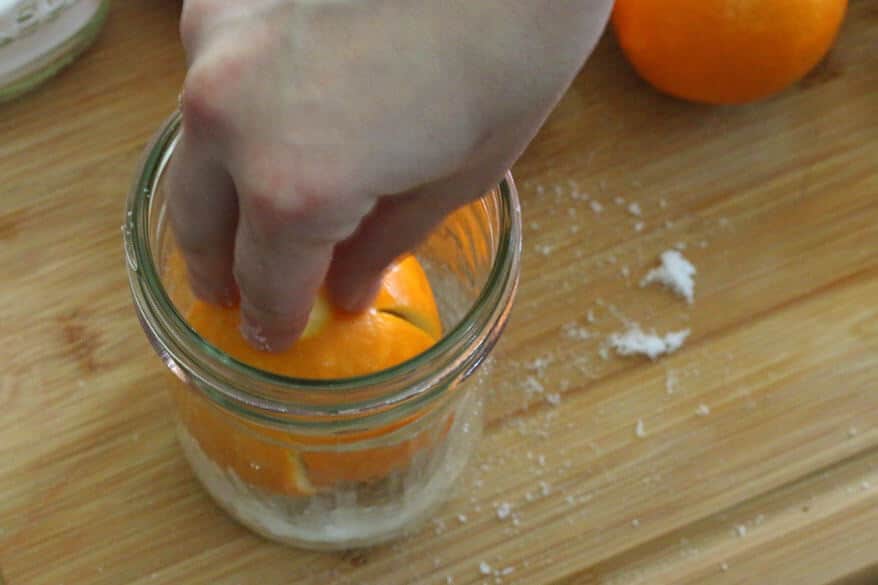
Put a teaspoon of salt over the top of the lemon.
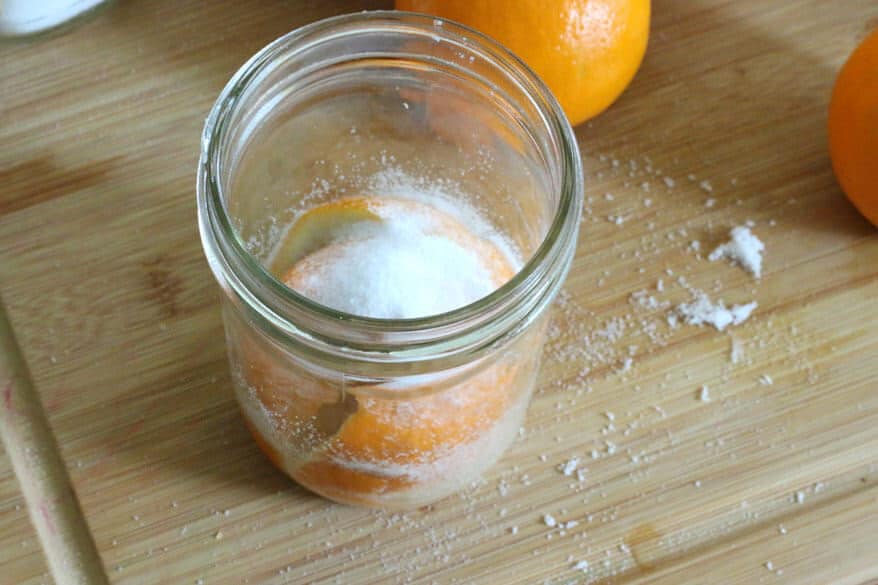
Repeat the process, putting a teaspoon of salt inside the second lemon, and then squish it down hard on top of the first lemon.
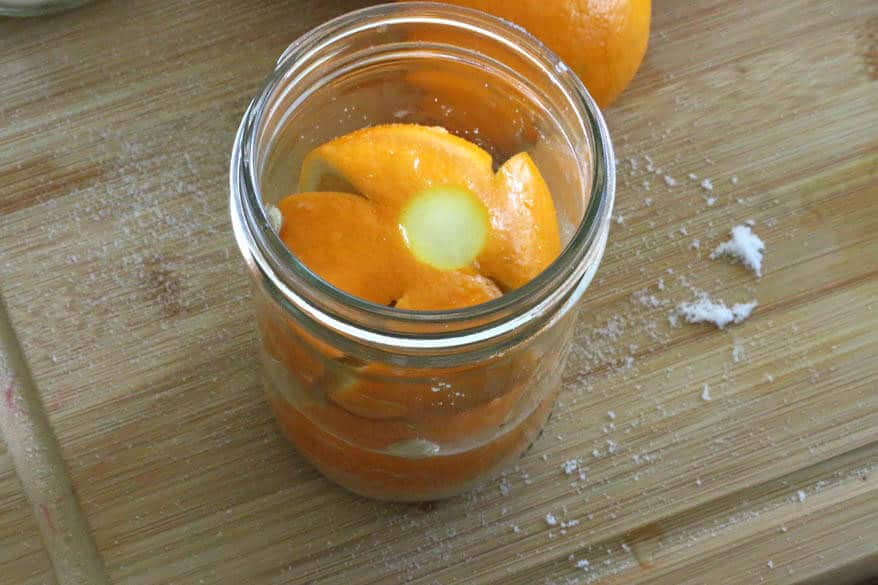
You got it – add another teaspoon of salt on top of the second lemon, and repeat the process for the third and final lemon. Add a teaspoon of salt on the very top. The jar should be at least halfway full of lemon juice from having compressed the lemons. If needed, squeeze some extra lemon juice into the jar to bring it to the halfway point. And don’t waste that lemon – cut it up and stuff it into the jar. Now pour some water that’s been boiled and cooled (sterile) into the jar to fill it up the rest of the way. Repeat this process for however many jars you wish to make.
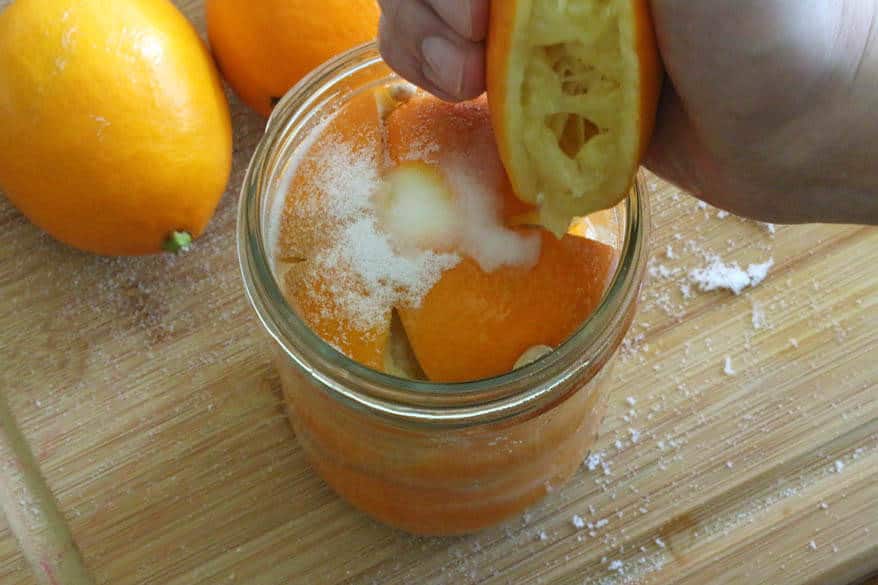
After you add the water, screw on the lid and let the jar sit at room temperature for 3 days, giving it a shake and turn it upside-down/right-side up a few times a day. After 3 days place the jar in the refrigerator and let it sit for at least 3 weeks before using. Keep the jar in the refrigerator. Whatever dish you use them in, discard the pulp (it’s the peel that is used) and thoroughly wash the peel to remove excess salt.
That’s it! Your preserved lemons are ready! *Taste bud choir breaks out into a stirring rendition of the “Hallelujah Chorus”*
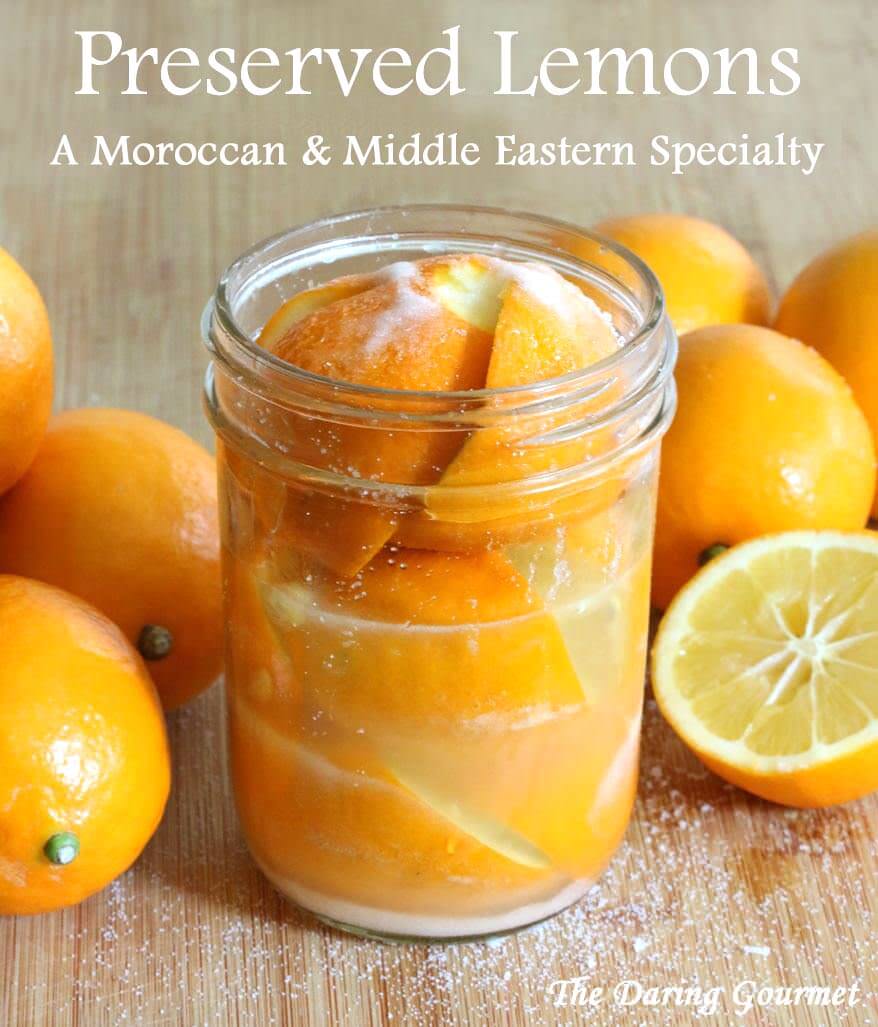
Save This Recipe

Preserved Lemons
Ingredients
- 3 Meyer lemons , or Eureka, Lisbon, etc, organic recommended per pint-sized jar
- 5-6 teaspoons sea salt or kosher salt (regular table salt contains iodine which will turn the lemons gray)
- An extra lemon for juicing
- Water that has been boiled and cooled sterile
Instructions
- Note: you can make however many preserved lemons you like, but roughly 3 will fit per pint-sized jar.Thoroughly clean the lemons. Organic is recommended. If you can't find organic, let the lemons sit in some vinegar water for a few minutes, then rinse.Trim the nubs off both ends of each lemon. Quarter each lemon, slicing them down just over 3/4 of the way to leave the slices attached at the end.Put one teaspoon of salt into the cavity of each lemon.Place one teaspoon salt into the bottom of the jar. Put a lemon in the jar, cut-side down, pressing firmly to squish out the lemon juice. Put a teaspoon of salt on top of the lemon. Firmly press the second lemon down on top of the first lemon. Repeat with the third lemon, pressing down firmly. Add a teaspoon of salt on top of the lemon.The jar should be at least halfway full with lemon juice. If needed, squeeze some additional lemon juice into the jar to bring it to the halfway point. Don't waste that lemon; slice it and stuff the slices into the jar. Pour the boiled/cooled water into the jar to fill it to the top.Screw the lid on and let it sit at room temperature for 3 days, shaking it and rotating the jar upside-down/right-side up a few times per day. After 3 days transfer the jars to the refrigerator and let them sit for at least 3 weeks before using. Stored in the fridge, they will keep for at least 6 months (see note).
Notes
* Whatever dish you use them in, discard the pulp (it’s the peel that is used) and thoroughly wash the peel to remove excess salt. * Using other citrus: You can also make preserved limes, oranges, grapefruit and kumquats! The process is identical but because high acidity is required for proper preservation you will still need to top off the jars with lemon juice.
Nutrition
Originally published on The Daring Gourmet April 8, 2014



















HI Kimberly, I was wondering why most recipes call for only cutting the lemon three quarters of the way through. I Have large ponderosa lemons and I can fit more in if they are completely
Quartered.
Thanks for the recipe I can’t wait to try them!
Hi Christine, it really just comes down to tradition and yes, you can cram those lemons in the jar any way you like just as long as they’re submerged/covered in liquid. Happy preserving!
NO. The preservation process DOES NOT make HYDROCHLORIC ACID!!! And if it did, you should not ingest that!
Fermentation in a salt brine can make LACTIC ACID. And yes, this recipe will preserve the lemons even if not refrigerated as long as they are completely under the liquid and jars are stored cool, out of direct sun light.
Can I use frozen lemons? I would thaw and then follow your recipe.
That should work though the texture will probably be mushier.
I have been using Robert Carrier’s recipe for preserved lemons (pretentious, moi?). But your method looks better, and I’ll be trying it next time – thanks.
I have a question: I’ve just made this recipe using a Mason canning jar, but I’m concerned about the possibility of the salt and acid of the lemons corroding the metal lid and contaminating the contents. Has anyone else used metal lids for this recipe?
Hi Valerie, does the inside of the metal lid have lining? If so, it will be fine. All canning jars are metal but have a lining on the inside part that touches the food.
Greetings! I made these (began) about 6 weeks ago and just took them out and food processed them. I missed the rinsing in cold water part and the blended product honestly tastes so salty and gross! Should I just scrap this batch and start again you think? I figured I could try a little in a fish or chicken marinade, but OH…..the saltiness!! :( Can’t believe I missed that step!
Hi Sarah, I cannot imagine eating these without rinsing them – yes, they would be unbearably salty. Also, you need to remove and discard pulp and then thoroughly rinse the rind. If you already discarded the pulp and just minced the rind up in a food processor, it may still be salvageable if you thoroughly rinse the minced pulp in a fine sieved colander.
Growing up I watched my mom make preserved lemons. Some of the other tricks are:
Clean and wipe dry the lemons
Sterilize the jar and wipe the inside dry
Use sea salt (Iodine will turn lemon brown)
Don’t add water
Slice lemons once then turn it and slice the other side (keeps the juice inside and speeds up the process)
Pack the jar tight with lemon to have less air inside the jar, my mom would place a sterilized stone to keep the weight on top
Always use utensils to remove needed preserved lemons from the jar, never your hands.
She never refrigerated the preserve, but I do since I don’t cook for a large family as she was used to:)
She would use the juices left in the jars for the next batch and so on…
She would soak needed lemon in cold water to get rid of some of the salt
My favorite recipe: Fresh Fava beans + chopped cilantro + half preserved lemon + olive oil +minced or (in powder) Garlic + cumin + paprika + cayenne pepper (adjust to taste) + little bit of water
NO SALT
Rather than dealing with the pulp and pith etc. can’t you just use a peeler to get the skin?
And turn over two thousand years’ worth of tradition upside-down??! ;) I don’t see why not, Gary. It might not be such a bad idea, especially if you have your own lemon tree and want to consolidate shelf space.
Jellification of the liquid?
I made this a year ago or so, and finally got around to using them last night. They’ve just been stored in my pantry and smelled and tasted fine, no mold or anything.
But I have a question – the liquid around the lemon had turned all jelly-like. My guess it is the pectin in the lemon peel, but I didn’t think it would get activated by the salt? Maybe it does. I mean there’s A LOT of pectin in there. Anyone else had same or similar experiences?
Hi Solveig, what I’ve noticed is that the flesh of the lemons becomes super mushy after a long time and makes everything a little congealed. That doesn’t pose a problem though, the flesh is discarded anyway and then rinse the peels as usual.
Mine did the same thing. I wondered whether they were spoiled, but they looked, smelled, and tasted fine. I think you’re right about the pectin.
I’m going to give this a try and have been thinking about how I might use them (besides your delish recipes) in the future. It seems to me that preserving them in slices might be convenient. Is there any reason that you can think of where I shouldn’t?
Hi Evie, no, the shape really makes no difference in the flavor outcome. Preserving them whole is simply traditional. And it just may be a little easier to remove the lemon flesh from a large chunk of peel rather than removing it from individual slices.
Last spring I made my first jar of preserved lemons. When they were done I discarded the pulp, rinsed them, then chopped them in the food processer and then put them in a jar covered with good olive oil. I leave it out on my counter and use it in salads, on top of green beans and broccoli. It’s been almost a year and I still have a little left. Yesterday I put up small oranges and blood oranges from my tree. Next week I will again do the lemons. Love, love them.
Thanks for the feedback, Mary, and I’ll bet the blood oranges will be amazing!
Can you use other than Meyer lemons for this recipe?
Yes, you can use any lemons, including the regular ones from the grocery store.
I love your pictures and simple instructions! I’ve just made 2 jars of the preserved lemons and have a question I don’t see posted. No matter how many lemons I put in the jar, they always rise to the top and the top parts aren’t covered by the liquid, even though the liquid is to top. I try to keep pushing them down but they rise above the liquid. Will the exposed part become moldy? Thanks!
Hi Pamela, that’s happened to me before as well. Yes, it will become moldy if the top is exposed for too long. So what I’ll do with those particular jars is either flip them every now and then or use up a lemon from each jar and fill up the jar with juice – at that point I haven’t had a problem with them rising back up.
I had the same issue so I took a clean round plastic lid and put it on top which pushed down the lemons under the brine when the jar lid was screwed on. Plastic may not be best choice but it is what I had. Will be on lookout for small glass or ceramic round things to use in future.
I found that using a sterilized empty plastic strawberry basket on top before topping off with water to the very brim makes a world of difference in keeping all lemons submerged.
O.K. Daring…followed your recipe many months ago and over a period of weeks made 6 more jars of various sizes consuming about 20 lemons. Daily vigorous shaking and finally the first jar taste; oh my! Salt! Salt! Salty! I reread the recipe. Oops. I used tablespoons not teaspoons. I removed the bulk of the still remaining sea salt rocks remaining from the jar and continue to use the remaining pickles, including the non rind parts, sparingly, for the last six months. Only a delish’ but wonderful tsp. left. After the first jar, I reduced the salt content with perfect results and continued the pickles using tumeric and black pepper. Wonderful. Thank you so much for the startup process. I have since done the same process with limes, adding daikon radish strips with grape leaves or summer squash strips with great success. I have let the inner part of the lemon remain and used it with the finished lemon or separately for dressings or sauces. Thank you again for starting on a new food thrill ride.
Wonderful, Allen! It sounds like you’ve become quite the preserving enthusiast – that’s awesome and thanks for sharing your experience!
This is my first time preserving and I used Meyers Lemons and also Rangpur Limes. They look beautiful in the jar and I’ll give as Christmas gifts to special cooking friends. One stupid question, what is the difference between juicing and freezing the juice for future use and preserving and using the rind…I admit to not trying any of the recipes yet…are the rinds more intense? Look forward to trying some of the recipes.
Hi MaryAnn, I’m not sure I understand the question. The juice from the lemons is used as the brine for preserving the rest of the lemon. If your question is what makes using preserved lemons different than just using the juice from lemons, then yes, there is a huge difference. This method of preserving using an ancient method knowing as fermenting where, through the growth of good bacteria over time, the food product itself undergoes changes that alter and intensify its flavor. Using fresh lemon juice or fresh lemon rind in a recipe will taste very different than using the preserved/fermented peel. You’ll see what I’m talking about once your lemons are done and you’ve had the chance to try them in a recipe.
Thank you so much for your prompt reply and yes I was asking the difference. I love canning and can’t wait to let others try these. Looking forward to trying the recipes. Peace and Merry Christmas to you.
Merry Christmas! :)
woohoo i followed your recipe.. They came out amazing!! I can’t wait to use them! I want to explore Moroccan recipes so that’s the reason for the lemons.. OMG Thank you I will let you know once they are ready. Im sure they are going to be DELISH :D
Awesome, Kelly! For terrific authentic Moroccan food, a great dish to start with is Djej Makalli. It’s so good!
I just made 3 jars of preserved lemons. i used myers lemons. Next week I will make more with regular lemons. Your recipe is really easy!
Yes,I will stay tuned. I really want to learn about Moroccan cuisine.. Thanks again :D